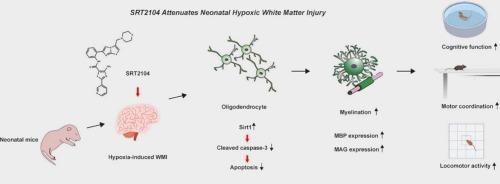SIRT1激活剂SRT2104减轻新生小鼠缺氧诱导的白质损伤
IF 2.6
4区 医学
Q3 NEUROSCIENCES
引用次数: 0
摘要
本研究探讨Sirtuin 1 (SIRT1)激活剂SRT2104对新生小鼠缺氧诱导的白质损伤(WMI)的影响。将C57BL/6小鼠从出生后第3天至第11天暴露于慢性缺氧环境中,建立小鼠新生WMI模型。SRT2104从第11天开始以2mg /kg或4mg /kg的剂量腹腔注射,持续5天。评估包括脑组织组织学、髓鞘形成标志物、少突胶质细胞分化和行为测试。结果表明,4 mg/kg SRT2104显著减轻组织损伤,通过提高髓鞘碱性蛋白和髓鞘相关糖蛋白表达促进髓鞘形成,通过降低cleaved caspase-3水平减少少突胶质细胞凋亡。在治疗小鼠的运动活动、运动协调和认知功能方面观察到行为改善。综上所述,SRT2104通过促进少突胶质细胞存活和髓鞘形成,对缺氧诱导的WMI具有保护作用,提示其可能作为新生儿缺氧WMI的治疗剂。本文章由计算机程序翻译,如有差异,请以英文原文为准。

The SIRT1 activator SRT2104 mitigates hypoxia-induced white matter injury in neonatal mice
This study investigated the effects of the Sirtuin 1 (SIRT1) activator SRT2104 on hypoxia-induced white matter injury (WMI) in neonatal mice. A mouse model of neonatal WMI was established by exposing C57BL/6 mice to chronic hypoxia from postnatal Day 3 to Day 11. SRT2104 was administered intraperitoneally at doses of 2 mg/kg or 4 mg/kg from Day 11 for 5 days. Assessments included brain histology, myelination markers, oligodendrocyte differentiation, and behavioral tests. The results demonstrated SRT2104 at 4 mg/kg significantly reduced histological damage, promoted myelination by enhancing myelin basic protein and myelin-associated glycoprotein expression, and decreased oligodendrocyte apoptosis by reducing cleaved caspase-3 levels. Behavioral improvements were observed in locomotor activity, motor coordination, and cognitive function in treated mice. In summary, SRT2104 demonstrates protective effects against hypoxia-induced WMI by promoting oligodendrocyte survival and myelination, suggesting its potential as a therapeutic agent for WMI in neonatal hypoxia.
求助全文
通过发布文献求助,成功后即可免费获取论文全文。
去求助
来源期刊

Brain Research
医学-神经科学
CiteScore
5.90
自引率
3.40%
发文量
268
审稿时长
47 days
期刊介绍:
An international multidisciplinary journal devoted to fundamental research in the brain sciences.
Brain Research publishes papers reporting interdisciplinary investigations of nervous system structure and function that are of general interest to the international community of neuroscientists. As is evident from the journals name, its scope is broad, ranging from cellular and molecular studies through systems neuroscience, cognition and disease. Invited reviews are also published; suggestions for and inquiries about potential reviews are welcomed.
With the appearance of the final issue of the 2011 subscription, Vol. 67/1-2 (24 June 2011), Brain Research Reviews has ceased publication as a distinct journal separate from Brain Research. Review articles accepted for Brain Research are now published in that journal.
 求助内容:
求助内容: 应助结果提醒方式:
应助结果提醒方式:


